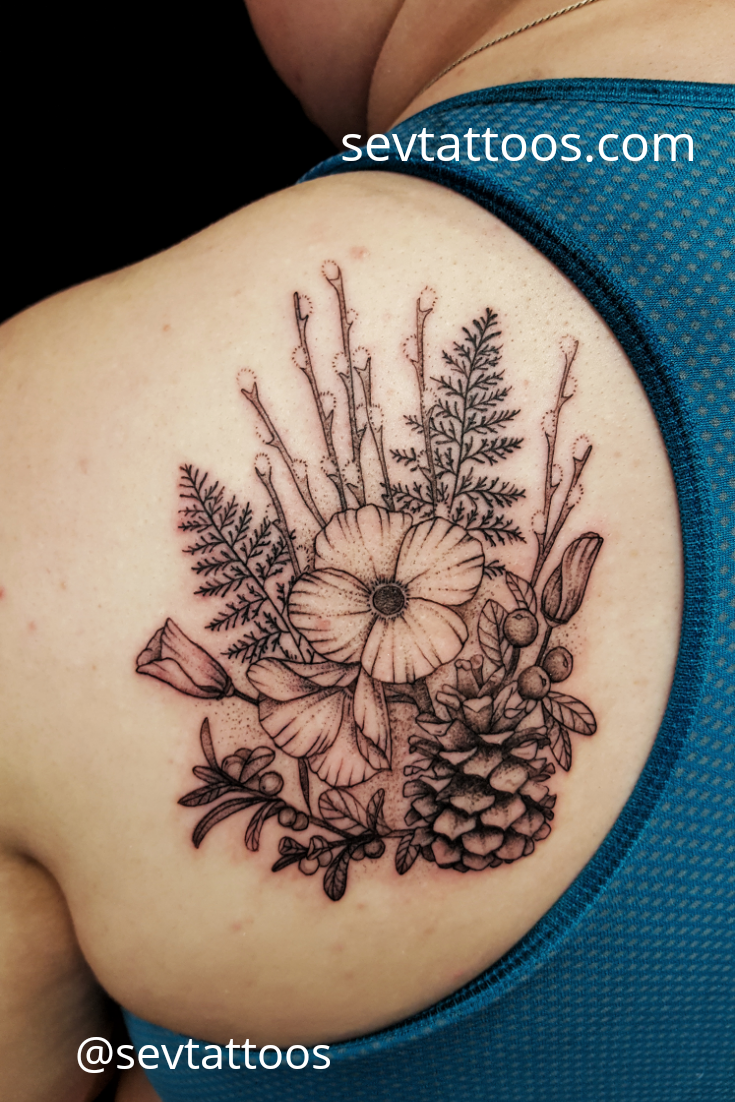After Your Ink

So, you found a talented artist, got the tattoo of your dreams, and are walking out of the shop…that’s awesome! Congrats on your new body art, but the job’s not done yet.
Aftercare is half the proverbial battle…are you well informed on it? Did your tattooer give you clear instructions? What are the best products to aid your healing process, and where can you find them? If you have any questions like this floating around in your head, or even just mild curiosity for future tattoo intentions, keep reading, this is for you!
Just to be clear, neither I, nor this post are sponsored by anyone. I am not a dermatologist or any other kind of health care professional. I’m a tattoo artist, and as such I can make informed recommendations, but if you have any reason to think your tattoo may be infected, please see your doctor. If you’re having any kind of issue with a tattoo, reach out to the artist who did it, as they can probably give you great advice, specific to your particular tattoo (style, placement, etc).
Okay, so first of all, these days there are two general categories of aftercare, either traditional, or using Saniderm (or another similar product, like Recovery’s Derm Shield, my favorite product). Let’s start with basic, traditional aftercare. When your tattoo artist finished your tattoo, they probably put some ointment on it and wrapped it in plastic. An hour or two after you get home, take off the plastic, wash your hands, and then wash your tattoo with liquid, unscented, antibacterial soap and lukewarm water. Classic gold Dial soap should do the trick. Either let your tattoo air dry, or pat it dry gently with a clean paper towel. No bar soap, and no cloth towels…both of these things can harbor bacteria, so stay away from them until the tattoo is healed.
When the tattoo is completely dry, with clean hands, put a very thin layer of ointment on it. Which ointment you use is up to you…A&D is a classic and seems to give most people good results, as do Aquaphor and Curad. Stay away from Vaseline. In my opinion, more natural products that are vegan and do not contain petroleum are better…some that I like are After Inked (the title of this blog is a nod to it, because I’m corny like that), and Hustle Butter. Coconut oil is also a good option. A lot of these products come in tubs. Something to keep in mind is cross-contamination…it’s best if you can use a popsicle stick or some other little utensil to scoop the ointment out, instead of just sticking your fingers in multiple times a day. This will decrease the chances that you’re accidentally contaminating your own ointment. For coconut oil, definitely make sure it’s a fresh jar, and not an older one that’s been sitting in your bathroom (or kitchen) for a while! Spread a very thin layer over your tattoo, you really just want a sheen of ointment. Too much may prevent air from getting to it, and this can slow your healing.
You’ll repeat the washing and ointment application a few times a day, for the first few days. Exactly how many times a day, and for exactly how many days, depends on your specific skin and lifestyle. Washing your tattoo 2-3 times a day, with maybe 3-4 ointment applications, should be fine for most people. However, if you have a tattoo in an area where it can easily get dirty (like if you’re a construction worker, and get a tattoo on your hand), more frequent washing may be necessary. That’s where common sense comes into it…don’t risk infection, but also don’t wash to the point where your skin is getting dry and you’re handling the tattoo too often.
Once your tattoo is starting to heal and the skin is closed (redness and swelling are gone, and the tattoo is starting to develop some thin scabs over the surface of it), you can switch from ointment to lotion. The best lotion for a new tattoo is something white and unscented…there are tons of different products fitting this description. You can also keep using coconut oil, if you think it’s been a good fit for your skin so far. Ointments are more protective, but usually less moisturizing, than a lotion with a thinner consistency. That’s why it’s good to switch products when your tattoo starts to dry out. However, if you feel that After Inked or something similar is doing a great job of keeping your tattoo moisturized, you don’t necessarily have to switch to lotion. If your tattoo feels dry, tight, or flakey soon after applying your ointment, definitely try some lotion though, and see if it makes a difference.
Generally speaking, tattoos take about three weeks to fully heal. After two weeks, they likely will have peeled, and now have a smooth surface that looks like it’s finished healing. It’s the deeper layers of your skin that need a little more time, which is why a new tattoo can sometimes look a little cloudy until after the three-week, or even one-month, point. If you’re getting a tattoo that needs multiple sessions, that’s why your artist will probably schedule your appointments about a month apart.
Exact healing times depend on your skin, where on your body you got the tattoo, how good you are with your aftercare, and the size and style of the tattoo. For example, a small piece that’s mostly lines will heal a lot faster than a big piece with lots of color, and a hand tattoo typically takes longer to heal than one on your arm. NEVER pick at the scabs/flakes, under any circumstances. Picking off a scab can pull ink out with it, resulting in a gaps and/or patchiness in your new tattoo. If it’s super itchy, put a little more lotion on it, don’t scratch.
Another good general rule is to keep your tattoo covered with clean, soft clothing for the first few weeks if possible, as you definitely don’t want it getting a lot of sunlight. After the three-week mark, it’s good to start using sunscreen if the tattoo is in an area where it’s likely to be exposed to a lot of sun. Similar rule with standing water…showers are fine, but keep your healing tattoo out of the bath, hot tub, pool, ocean, etc…until it’s fully healed, minimum of three weeks to be safe!
That’s the basics of traditional aftercare…now let’s talk about Derm Shield. Derm Shield, by the brand Recovery, is medical-grade plastic bandaging that can stay on your fresh tattoo for multiple days. It’s waterproof, but breathable. The benefits of it over traditional aftercare are ease of use, less initial handling of the fresh tattoo (and therefore less chance of infection), protection from friction of clothing, and anything else in your environment like dust, pet hair, etc.
I usually put a slightly oversized piece of Dern Shield over my client’s tattoo (I like there to be a generous margin of product around it), and ask them to leave it on for three days. During those three days, black or greyish fluid will collect under it (a bit of excess ink, blood, and plasma). This is completely normal, and having your own plasma against a healing wound (in a situation like this where it won’t grow bacteria) is good for your skin.
During the three days, you can shower as normal, but try not to sweat too much as it can make the product start to loosen prematurely. When it’s been about 72 hours, peel it off gently, ideally in the shower where the warm, wet conditions can help it release from your skin more easily. Wash it gently but thoroughly with liquid antibacterial soap, pat it dry with a clean paper towel or let it air dry, and then apply lotion. Essentially, you’re using Derm Shield instead of ointment.
If your tattoo artist doesn’t offer a product like this, you can order it yourself on Amazon. There are other similar products, and of the three or four that I’ve tried, Recovery Derm is my favorite. It’s easier to put on, and seems less inclined to cause irritation.
About 1/3 of my clients have allergic reactions to Saniderm. This presents as redness, itching, sometimes dryness or a little swelling under the Saniderm (usually the most noticeable right around the edges, so people are sometimes left with a red, square outline around their tattoo for days, or even weeks). I’ve used Saniderm on a few of my own tattoos, and there are some areas on my body where it causes irritation, and some where it doesn’t. I now only use Derm Shield on myself, and although it can start feeling itchy if I leave it on more than three days, I never get a rash or redness from it. Whether a product like this is right for you and your skin type is hard to know without just trying it.
Even if you have a bad reaction to it, that reaction will most likely just be annoying, not damaging to the tattoo itself. However, if you have very sensitive skin, I’d stick with traditional aftercare. Your tattoo artist should be able to give you additional info on using (and removing) Saniderm/Derm Shield, and if it’s likely to work well for your specific tattoo. If you’d like me to go into detail on using it at home, just comment below or send me an email!
As I said above, Saniderm and Recovery’s Derm Shield, along with other similar aftercare products, can be found on Amazon. Everything I’ve mentioned so far can be ordered online…After Inked, Hustle Butter, and other petroleum-free aftercare are all readily available, and usually $20-$30 for large tubs that will last you a very long time. If you find a product that you like the sound of, but you’re not sure if it’s appropriate for a healing tattoo, check with your artist first (they may already be familiar with it, and if not, maybe send them a photo of the label and ingredients list).
The last bit of advice I have on general aftercare is to keep doing it…well, forever. Find a lotion you love, and use it on your tattoo for the rest of your life. Your skin absorbs moisture the best right after a shower, and does the most healing while you sleep. I usually shower at night, slather myself in lavender lotion, and go to bed. Good skin advice is pretty much the same as regular health advice…stay hydrated, get enough sleep, eat well, exercise, use sunscreen, and moisturize daily, and your tattoos will have the best possible longevity!
Thanks for reading, and happy healing!




